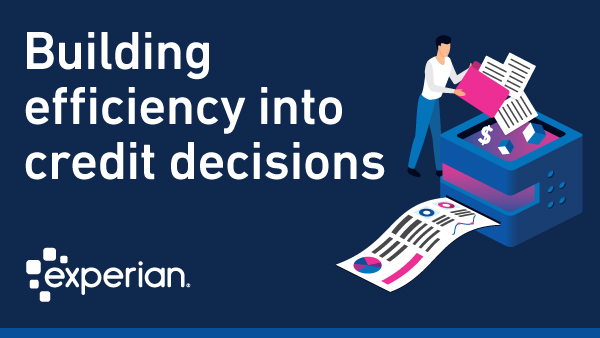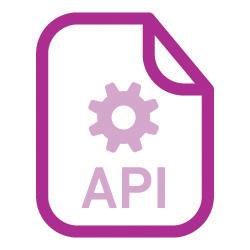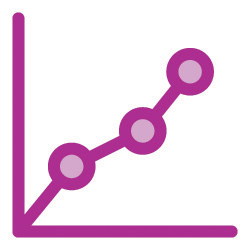Improve customer experience while boosting profitability through automation

As a credit manager or risk manager, you need real-time data to determine the right credit terms for each customer. Does the company pay its bills on time? Is it growing, or is it in danger of going out of business? What debts are outstanding? It’s easy to see how granting credit to the wrong customer can harm your business but limiting credit to financially solvent customers also limits the growth of your own company. We’re going to talk about automating credit decisions in this post and some action steps you can take toward greater efficiency and profitability.
The importance of credit decisions is especially urgent now as we enter a bear market following some significant turbulence in the regional banking space. The decisions companies make when times are good determine their ability to stay in business through the next recession. Your business simply can’t succeed unless you consistently make smart credit decisions. And the secret to making the right credit decisions efficiently starts with modernizing your credit approval process.
While it’s easy to think about credit decisions with new customers, the process actually occurs throughout the customer buying life cycle — prospecting, acquisition origination, account management and collections. When you have an inefficient manual process for credit decisions, you lose a significant amount of productivity and time. If you take up to 30 days to make a credit decision, there’s a good chance your potential customer will turn into your competitor’s customer. Additionally, manual credit decisions, by nature, exist in a silo and can’t be used by other departments and processes, which adds to the inefficiency.
Companies can leverage the latest in data science and technology by moving to highly automated data-driven decisions. In addition to making more accurate decisions, you can improve efficiency significantly by making faster decisions that allow you to turn prospects into customers more quickly. With a modern credit decision engine, you can also share data with other vendors, departments and systems through application programming interface (API) integrations.
But true efficiency is about more than making a single accurate decision. It’s also about creating a credit policy using data models and then automating that policy to increase both accuracy and efficiency. You can then consistently apply the data science to each decision and each application in a way that’s repeatable. Because each company has its own risk tolerance, credit policy and credit approach, your model must be specifically customized to be most effective.
This article provides the road map you need to modernize your credit decision process. By understanding the steps involved in creating an automated process, you can begin to evolve your credit decisioning into an efficient process that increases revenue and productivity.
How to automate credit decisions and real-time responses
When a new customer wants to establish credit terms with you, the first thing they’re asked to do is to fill out your credit application. When you hand over a paper application, did you know you could be negatively impacting your revenue or providing a poor customer experience? Some companies don’t.
More than likely, your customer has filled out at least one digital application in the past. When you use paper, your customers may perceive your company as out of step with technology, which can lead your customers to wonder where else you’re lagging behind.
Digital applications provide a simplicity factor, and when you don’t offer one, your credit approval process is more difficult for customers, leaving them with more work to do — wasting time handwriting their information and then returning the application by email, by fax or in person. Because many companies have already moved to a digital application, your pen-and-paper process sticks out to customers — and not in a good way.
And manually processing a paper application takes longer — often much longer — than a digital application. Customers leave without a credit approval, giving them time to change their mind about their purchase or find a better deal, which means you just lost a new sale. Even if they still choose to work with you, their relationship with your company starts out with a mediocre customer experience.
After the paper application is completed, the workflow process is often time-consuming, error-prone and cumbersome, and the time involved means that your company waits longer to get the revenue from the sale. By using a manual process, your team spends hours on processing and decisions that could be better spent servicing customers directly or working on other initiatives to grow your business.

Putting the credit application online for laptop, tablet, or smartphone use
As customer experience becomes more critical to how businesses compete and differentiate themselves in the marketplace, companies inevitably will continue to move toward digital applications. Some companies include a link to their online credit application on their website so customers can fill it out from anywhere, anytime they want. Other companies operating physical storefronts will give customers a tablet so they can fill out the digital application right then and there.
Companies with sales representatives who go into the field can also use the system for credit approvals by simply handing their tablet or smartphone over to the customer. When sales reps have the power to easily convert sales on the spot, you can increase revenue and improve the customer experience at the same time. And your sales reps’ satisfaction improves, because you’re giving them tools to help drive their success.
Automating the decisioning process

Some companies improve the application process further by automating credit approvals. Real-time decisions give customers something they often expect — instant gratification. With a digital application, you can extend credit and issue payment terms that work for your customer, which prevents them from shopping around. If a potential customer leaves your site or store without a credit decision, you could easily lose their interest, and they might never come back.
When your customer completes the application and clicks Submit, the automated decisioning process can initiate instantly. Because the application is digital, the system can render a decision immediately, display it onscreen and send the applicant a confirmation email. Your employees no longer have to look at each application by hand — just those flagged by the system as needing a human touch.
The decision is based on rules and parameters you set up in the system’s decisioning engine to determine credit approval. Because different companies have different levels of risk — some are more risk-averse, while others are more aggressive — you can set up a decision policy based on the specific criteria that work for your company. This also means less friction between the credit department and sales, because the credit policy is already preconfigured with clearly defined criteria. This can help sales representatives better manage expectations with their customers.
Improving the workflow

Your company likely already has an established workflow process for credit applications. Many automated application processing and decisioning technologies are designed so you can leverage certain components and integrate them into your process as you see fit. This enables added flexibility and customization when moving your existing process to an online format. Experian® provides several standard workflows for customers to use as is. You can also quickly modify an existing workflow or, potentially, use API integrations to build automation into your existing processes and systems.
Modernizing the end-to-end credit approval process can feel daunting in the beginning. Start by identifying specific credit department processes that can be easily automated right away and that can drive quick, impactful returns. By starting small, you can implement and manage change more easily over time. As your business and stakeholders become more comfortable, you can continue to automate more pieces of the process to drive incremental returns. Eventually, your company could automate the entire credit approval process. No more paper applications, and no more frustrated customers.

Integrating credit decisions with the back office
When you’re launching a new product or business line or starting a new business, you need to move fast and break things. This means taking a minimum viable product (MVP) approach, where you sacrifice scalability by implementing manual processes to support the early stage business. Commonly, a manual process will be in place for credit applications and approvals — pulling the credit report, reviewing the data against a scorecard or policy, and then making the decision. Since this can take a day or even longer, the process damages your customer’s experience, and it can hurt your ability to scale and grow revenue the longer you wait to automate.
To grow the business and take it to the next level, you need to move away from the paper-pushing approach. The next step is moving toward an automated solution that integrates credit decisions with the back office, such as an Enterprise Resource Planning (ERP), a Customer Relationship Management (CRM) or another custom system that employs APIs.

An application programming interface, or API, is many things. It’s a set of instructions and technical documentation for developers. It’s a collection of services that let you interact with a product or service. And it’s a way for businesses to open up and allow for new kinds of innovation — allowing for new business models and application development that wouldn’t be possible without APIs.
In the last decade, APIs have become system-agnostic, meaning they plug and play into nearly any system because they’re standardized and popular among the development community.
Every API that we have is delivering data that we have in real time. You can use that data to make decisions in real time.
Carl Stronach, Experian
Because of this popularity, APIs make it easier for the business to get buy-in from the IT department, which is essential to automating the credit decisioning process. Without an API, more infrastructure will be required to host a large database, which means the IT department will need to devote significant resources to the project. APIs allow you to pull data in real time only when you need it, reducing system complexity and decreasing application development costs. Reduced complexity also means less risk, because you’re more assured that your IT department will be successful with the integration. Often, when IT departments are presented with information about the API, their response is “No problem.”
How does your decision engine interact with APIs? You can use APIs to get the raw data elements your credit policy or model needs to render a decision, whether the data is internal to your business or provided by third parties.
Taking decisions to the next level with machine learning

According to a recent Harvard Business Review project, the key to using machine learning successfully isn’t getting caught up in new and exotic algorithms, but making the deployment of machine learning easier. There are many use cases where machine learning can be employed, but use cases where data-driven decisions are being made, as in the credit approval process, are archetypical.
During the early stages of the machine learning process, you train the model by feeding it data from past applications. Then, as you use the engine for real-time processing, the engine learns from past decisions.
If the engine was originally approving applications with a borderline credit score but found that these applications often ended up being poor risks, the model would then begin turning down these applications.
The key ingredient in making machine learning start to work for your credit department is to have domain experts — credit managers — help the IT department focus on the key variables that can help the machine learning model predict key outcomes like credit losses, bankruptcies and business failures and put the models through many rounds of testing and validation before putting them into practice in real life.
Now is the time to move your manual processes online using an API and machine learning. According to Mary Meeker’s 2018 Internet
Trends report, 60 percent of customers pay online, while only 40 percent pay in-store. And that gap likely will continue to grow. The longer
you wait, the further ahead your competitors will be in digitizing the customer experience — and the harder it will be to regain your
footing and catch up.
Now is the time to move your manual processes online using an API and machine learning.
Why data models matter more than ever
Are the credit models you’re using to make lending decisions more than 2 or 3 years old? If so, you’re likely making less-then-optimal credit decisions. You may be turning down customers who are a good risk, while taking on customers who are more apt to default on their obligations. Every year a model isn’t updated, its accuracy decreases. The economy changes. The consumer’s or business’s financial situation changes. When you update your models using the most current data and attributes available, you can be confident that you’re making good credit decisions.
To make the most accurate credit decisions possible, many businesses are turning to data-driven decisioning models powered by artificial intelligence (AI) within machine learning engines.

While the standard regression model works well in some industries, the lift in predictive value from using AI data models can be very important in other industries, such as retail, fraud and marketing. These models use sophisticated algorithms to predict customers’ future ability to repay their obligation, which means a much more accurate decision than traditional models.

Watch our 15-minute Sip and Solve talk
Modernizing your credit approval process can feel daunting in the beginning stages, but it doesn’t have to be. By starting small with some basic automation principles and tips, you can begin to implement change more easily over time in order to drive incremental returns for your business. As you and your stakeholders become more comfortable with these changes and see the tangible benefits, you can continue automating more pieces of the process to drive even more value.
Starting with high-quality data
Data has always been at the core of credit decisions, but models using machine learning are even more dependent on data. These models can be very accurate, but their accuracy depends on having the necessary data to understand both what happened in the past and present behavior to make a prediction for what will happen in the future. The more data provided, the more accurate the decision will be. Three things to consider when building your data-driven decisioning model:

Clean data— As innovation spurs business and technology to run faster and be more efficient, the quality of the underlying data becomes even more important. Machine learning becomes smarter as it consumes more data, which means the accuracy of the model’s credit decisions is largely dependent on the quality of the data provided. Data from third-party sources often contains mistakes, missing fields and duplicate information, which can result in less accurate credit decisions.

Correct data points — The accuracy of the results depends on considering the right criteria in the form of data points in the model. Machine learning and AI algorithms can predict which specific data points will help increase the model’s performance for the specific customer and the specific type of credit decision. Often, you may fail to consider data points that can make a big impact on the accuracy of the decision.

Real-time data — In the past, there was often significant lag time between collecting data and being able to use it. By using real-time data with machine learning models, you can get a clear picture of the most current view possible and see changes in the different data points as they occur. This lets you make a much more accurate prediction of what will happen with the consumer or business than you could with a traditional credit decisioning process.
Using alternative data to get the full picture
Often, additional data — typically referred to as alternative data — that isn’t readily available from traditional data providers is used to enhance a model’s accuracy and predictive ability. The model may seem complete, but without this information, it can provide suboptimal results. Machine learning models can predict the situations and exact type of alternative data a model needs to produce an accurate decision. Experian offers a wide variety of alternative data clients can use to improve decision models.
For example, a business owner taking out short-term loans to increase her cash flow is a much higher credit risk than she appears to be without this data. Weather information is also a common type of alternative data; a business located in Tornado Alley may need higher cash reserves to be a good credit risk. On the other hand, businesses located in an area impacted by a recent weather event, such as a hurricane, may be a good credit risk even with a lower score, because both their business and the local economy are recovering.

Regularly evaluating your data model
You must build in governance and make sure you’re evaluating how the model is working on a regular basis, like having an annual checkup with your healthcare providers. Once you start using a data model, you can’t just set it and forget it. Ask the following questions to periodically evaluate your models:
- Are there changes in the model’s outcome? You need to verify that your attributes are still predicting the intended outcomes, as well as capturing the same data. Say your model has an attribute that counts the number of credit lines open for a small business. If the attribute changes and those types of credit lines are no longer reported by the data provider, that number can go from three or four to zero without any change in the number of the business’s open credit lines. Because the data that goes into your model has changed, it won’t be accurate until you update the attribute.
- Is your model stable? You need to make sure degradation hasn’t reached a point where the predictive value is no longer accurate. For example, scores before and after the 2008 recession have a different meaning due to the changes in the financial system.
The future of your business depends on your ability to make accurate credit decisions. Instead of using outdated models, take advantage of the latest technology and methods available by using machine learning data-driven models. The process is simple and quick and most importantly, data-driven models are accurate.
Tying it all together
Modernizing the end-to-end credit approval process can feel daunting in the beginning stages. But finding a service provider that offers flexible solutions and guidance to help kick-start the process can better position you for success. Experian’s decisioning services are positioned to provide maximum flexibility to our clients. We will summarize how each Experian decisioning solution can help you, depending on how far along in automating your credit approval process.
DecisionIQSM — Get started with speed and simplicity
For companies that are new to modernizing the credit approval process or have a limited technology budget, starting with a simple, web-hosted decisioning tool like DecisionIQ can be a good option. Basic access lets clients build policies leveraging scorecards, exception rules and credit limits prebuilt by Experian. The DecisionIQ simple policy wizard can get you up and running in minutes, and it’s ideal for companies looking for an off-the-shelf starting point for making faster, more reliable credit decisions.
DecisionIQSM Plus — Add customization and precision for improved risk management
Companies that have more experience in automated decisioning or operate in a complex business model likely are looking for specific customizations to help drive incremental returns within their risk management process. DecisionIQ Plus is designed to help clients facilitate blended scorecards so they can assess risk on small businesses in the United States quickly and easily. This becomes particularly important when these small-business customers lack a commercial credit footprint or support their business operation using the owner’s personal credit. DecisionIQ Plus can also be leveraged to build commercial scorecards on international businesses. Given the continued growth of international commerce, these data assets prove essential for many clients expanding globally.
DecisionIQSM Premier — Expedite customer onboarding and improve the customer experience
For companies with the most advanced automated decisioning that are moving from improving the risk management function to deploying a streamlined onboarding experience, DecisionIQ Premier is designed to help companies build and deploy online credit applications in real-time. Once activated, these online credit applications can capture, route, and store an applicant’s submitted information within the DecisionIQ-hosted workflow. Companies can also configure the online credit application to sync with their automated decision policy, making it easy to render instant onscreen approvals and email communications at the point of sale. By linking an online credit application with a live credit policy, DecisionIQ Premier can help improve a company’s speed to revenue and its ability to compete in the marketplace.
